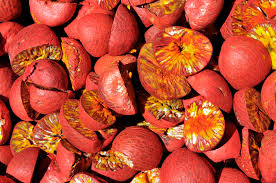 Areca nut is the seed of Areca catechu, a species of palm tree.
Areca nut is the seed of Areca catechu, a species of palm tree.
This tree grows in tropical Pacific, Asia, and East Africa.
More than 600 million people, primarily in Asia and Asian migrant communities chew areca nuts, and use his highest among adolescents and adults younger than 40 years.
It is commonly prepared as betel quid, which combines areca nuts, and betel leaves.
The areca nut or betel nut is the fruit of the areca palm (Areca catechu), which grows in much of the tropical Pacific (Melanesia and Micronesia), South Asia, Southeast Asia, and parts of east Africa.
Consumption by hundreds of millions of people worldwide – mainly of South Asian or Southeast Asian origins.
It is not betel, leaves that are often used to wrap it.
The practice of chewing as a stimulant drug continues to the present day in many countries.
Consumption has harmful effect.
It is carcinogenic.
Compounds present in the nut, include arecoline, a stimulant alkaloid which is similar to nicotine.
Arecoline contributes to histologic changes in the oral mucosa as well as discoloration of the gums, and is known to be a major risk factor for cancers-squamous cell carcinoma of the mouth and esophagus.
The areca nut is not a true nut.
It is the seed of a fruit categorized as a berry.
It is commercially available in dried, cured, and fresh forms.
For chewing slices of the nut are wrapped in a betel leaf along with calcium hydroxide and may include clove, cardamom, or other spices for extra flavoring.
Areca nuts are chewed for their effects as a mild stimulant.
They cause a warming sensation in the body and slightly heightened alertness, with varying effects vary from person to person.
Chewing, areca nuts may be associated with mild euphoria, has addictive potential, and may be associated with withdrawal symptoms of irritability and anxiety.
It is a type one carcinogen as noted by the International Agency for Research on Cancer.
Chewing on a Rican nuts is associated with abrasion and inflammation of the oral mucosa, allowing the nut components to penetrate the oral mucosa.
Alkaloids in Areca nuts increase collagen synthesis, causing the mucosal fibrosis.
Areca nuts promote malignancy, by up regulating p53, hypoxia inducible factor 1 alpha, and other angiogenesis related molecules.
In parts of India, Sri Lanka, and southern China, areca nuts are chewed along with betel leaf, and also used in the preparation of traditional Chinese medicines.
Powdered areca nut is used in some dentifrices, chewing areca nut and betel leaf is a good remedy against bad breath.
Chewing betelnut produces a red residue, with red-stained teeth and gums from long term use.
Several adverse effects and diverse pathologies may result from consuming areca nuts, affecting almost all organs of the human body, including the brain, heart, lungs, gastrointestinal tract and reproductive organs.
Areca nuts cause or aggravates pre-existing conditions such as neuronal injury, myocardial infarction, cardiac arrhythmias, hepatotoxicity, asthma, central obesity, type II diabetes, hyperlipidemia, and metabolic syndrome.
It affects the endocrine system, leading to hypothyroidism, prostate hyperplasia and infertility.
It affects the immune system leading to suppression of T-cell activity and decreased release of cytokines.
It has harmful effects on the fetus when used during pregnancy.
There is an association between habitual chewing of areca nuts and oral cancer, throat cancer and increased risk of cirrhosis and hepatocellular carcinoma.
Chewing areca nuts is a cause of oral submucous fibrosis, a premalignant lesion which may progress to mouth cancer.
There may additionally be a higher risk of cancers of the esophagus, stomach, prostate, cervix, and lung.
Areca nut consumption may increase the risk of chronic kidney disease in males, and of milk-alkali syndrome.
Using tobacco or areca nuts during pregnancy significantly increases adverse outcomes for the newborn with higher incidences of preterm birth and low birth weight and height.
Biologically, these effects may be a consequence of the arecoline that is found in areca nuts.
Chewing the mixture of areca nut and betel leaf constitutes an important and popular cultural activity in many South Asian, Southeast Asian, East Asian and Oceanic countries.
